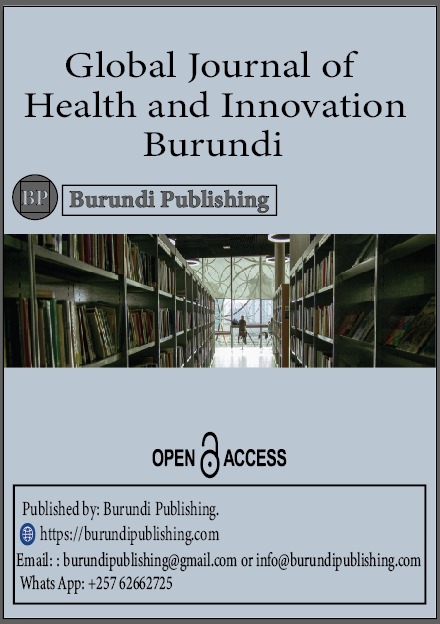THE CONTRIBUTION OF HEALTH SYSTEM STAKEHOLDERS ON THE PREVENTION OF GUINEA WORM DISEASE IN HUMANS AND ANIMALS IN LAFON AND TONJ EAST, SOUTH SUDAN. A CROSS-SECTIONAL STUDY.
DOI:
https://doi.org/10.70659/gjhib.v2i2.23Keywords:
Health system stakeholders, Prevention of Guinea Worm Disease (GWD), Guinea Worm Disease in humans, Lafon, South SudanAbstract
Background.
Eradicating Guinea worm disease (GWD) is a critical global public health goal that requires collaborative efforts from diverse stakeholders. This parasitic disease, once widespread, is now on the brink of eradication thanks to sustained efforts by governments, international organizations, and community leaders. This study examined the contribution of health system stakeholders and the prevention of GWD in humans and animals in Lafon and Tonj East, South Sudan.
Methodology.
A descriptive study design was employed, utilizing both qualitative and quantitative research methods. Data were collected through surveys and interviews with 150 participants, including healthcare providers and residents of Lafan and Tonji Counties. Statistical analyses were conducted using regression models and correlation matrices to evaluate the relationship between the GWD prevention strategies.
Results.
47 (32%) of the participants had known GWD for 2-5 years, and 20 (29%) had a secondary education. Approximately 82.4% of the variance in behavior change effectiveness (R Square = 0.772, Adjusted R Square = 0.662). Notably, each component of the health systems stakeholder’s strategy contributed positively to prevention showing the strongest influence (Coefficient = 0.313, p < 0.001), followed by UN and partners' (Coefficient = 0.291, p < 0.001), and access to knowledge provided by NGOs' (Coefficient = 0.284, p < 0.001).
Conclusion.
No evidence of association was found between health system stakeholders and the adoption of GWD prevention strategies.
Recommendations.
People involved in Guinea worm eradication should be recognized for their role in reducing the spread of the disease. The last recognition was done in 2017 by the crown prince of the Court of United Arab Emirates. This should be done more often.
References
Biswas, G., Sankara, D. P., Agua-Agum, J., & Maiga, A. (2016). Dracunculiasis (Guinea Worm Disease): Eradication Without a Drug or a Vaccine. Health Research Policy and Systems, 14(1), 1-12. https://doi.org/10.1186/s12961-016-0080-5
Cairncross, S., Muller, R., & Zagaria, N. (2012). Dracunculiasis (Guinea Worm Disease) and the Eradication Initiative. Clinical Microbiology Reviews, 15(2), 223–246. https://doi.org/10.1128/CMR.15.2.223-246.2002
Hopkins, D. R., Ruiz-Tiben, E., Weiss, A., Withers, P. C., Eberhard, M. L., & Roy, S. L. (2013). Dracunculiasis Eradication: Are We There Yet? American Journal of Tropical Medicine and Hygiene, 89(1), 4–10. https://doi.org/10.4269/ajtmh.13-0092
World Health Organization (WHO). (2023). Progress Towards Dracunculiasis Eradication – Global Update. Weekly Epidemiological Record, 98(27), 283-292. Available at: https://www.who.int/publications
UNICEF. (2019). The Role of Partnerships in Disease Prevention: A Case Study of Guinea Worm Disease Eradication. UNICEF Publications. Available at: https://www.unicef.org
Amin, M. E. (2005). Social Science Research: Conception, Methodology, and Analysis. Makerere University.
Creswell, J. W. (2013). Qualitative Inquiry and Research Design: Choosing Among Five Approaches. SAGE.
Doebley, J. F., Gaut, B. S., & Smith, B. D. (2006). The molecular genetics of crop domestication. Cell, 127(7), 1309–1321. https://doi.org/10.1016/j.cell.2006.12.006
Gay, L. R., & Airasian, P. W. (2003). Educational Research: Competencies for Analysis and Applications. Merrill/Prentice Hall
Malhotra, N. K. (2010). Marketing Research: An Applied Orientation. Pearson Education.
Molyneux, D. H., Eberhard, M. L., Cleaveland, S., Addey, R., Guiguemdé, R. T., Kumar, A., Magnussen, P., & Breman, J. G. (2020). Certifying Guinea worm eradication: Current challenges. Lancet (London, England), 396(10265), 1857–1860. https://doi.org/10.1016/S0140-6736(20)32553-8
R. Gibbs, G. (2007). Analyzing Qualitative Data. SAGE Publications, Ltd. https://doi.org/10.4135/9781849208574
Sekaran, U. (with Internet Archive). (2016). Research methods for business: A skill-building approach. Chichester, West Sussex, United Kingdom: John Wiley & Sons. http://archive.org/details/researchmethodsf0000seka_l8p5
Downloads
Published
How to Cite
Issue
Section
License
Copyright (c) 2025 Makoy Samuel Yibi Logora, Kateregga Salongo, Dr. Denis Mubiru, Dr. Sendagi Mohammed

This work is licensed under a Creative Commons Attribution 4.0 International License.
License Information
All articles published in the Global Journal of Health and Innovation Burundi are licensed under the Creative Commons Attribution 4.0 International License (CC BY 4.0).
This license permits:
- Sharing: You can copy and redistribute the material in any medium or format.
- Adapting: You can remix, transform, and build upon the material for any purpose, including commercially.
Attribution Requirement: Users must provide appropriate credit to the original author(s), link to the license, and indicate if changes were made.






